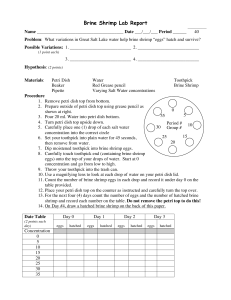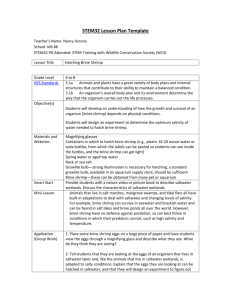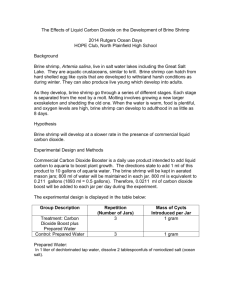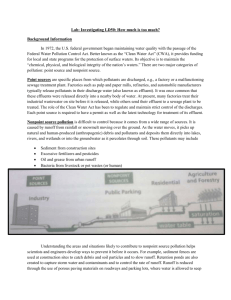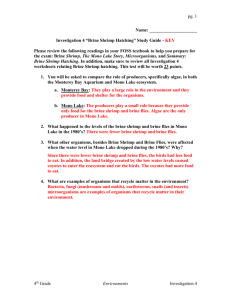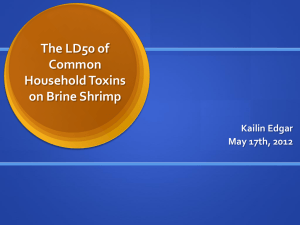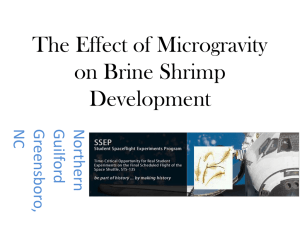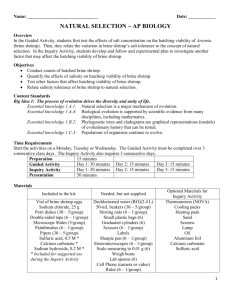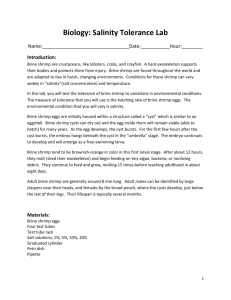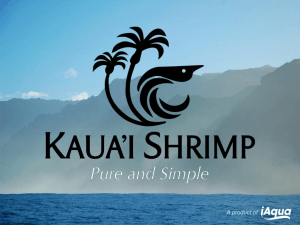AP Biology Name AP Biology Lab Introduction Group Member
advertisement
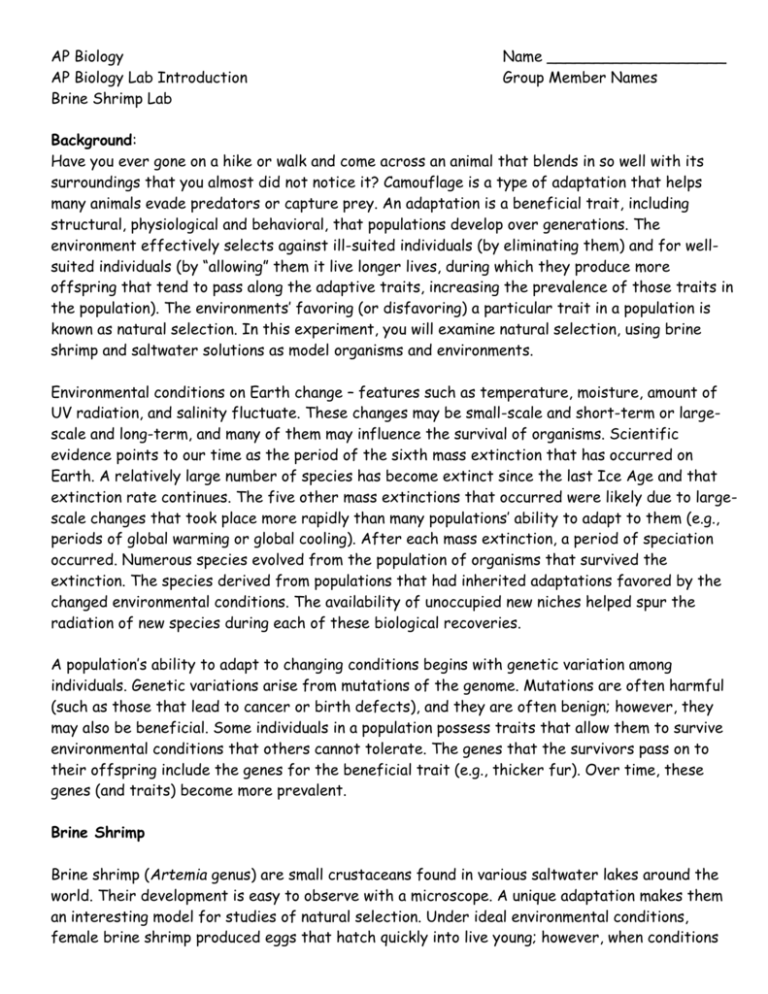
AP Biology AP Biology Lab Introduction Brine Shrimp Lab Name ___________________ Group Member Names Background: Have you ever gone on a hike or walk and come across an animal that blends in so well with its surroundings that you almost did not notice it? Camouflage is a type of adaptation that helps many animals evade predators or capture prey. An adaptation is a beneficial trait, including structural, physiological and behavioral, that populations develop over generations. The environment effectively selects against ill-suited individuals (by eliminating them) and for wellsuited individuals (by “allowing” them it live longer lives, during which they produce more offspring that tend to pass along the adaptive traits, increasing the prevalence of those traits in the population). The environments’ favoring (or disfavoring) a particular trait in a population is known as natural selection. In this experiment, you will examine natural selection, using brine shrimp and saltwater solutions as model organisms and environments. Environmental conditions on Earth change – features such as temperature, moisture, amount of UV radiation, and salinity fluctuate. These changes may be small-scale and short-term or largescale and long-term, and many of them may influence the survival of organisms. Scientific evidence points to our time as the period of the sixth mass extinction that has occurred on Earth. A relatively large number of species has become extinct since the last Ice Age and that extinction rate continues. The five other mass extinctions that occurred were likely due to largescale changes that took place more rapidly than many populations’ ability to adapt to them (e.g., periods of global warming or global cooling). After each mass extinction, a period of speciation occurred. Numerous species evolved from the population of organisms that survived the extinction. The species derived from populations that had inherited adaptations favored by the changed environmental conditions. The availability of unoccupied new niches helped spur the radiation of new species during each of these biological recoveries. A population’s ability to adapt to changing conditions begins with genetic variation among individuals. Genetic variations arise from mutations of the genome. Mutations are often harmful (such as those that lead to cancer or birth defects), and they are often benign; however, they may also be beneficial. Some individuals in a population possess traits that allow them to survive environmental conditions that others cannot tolerate. The genes that the survivors pass on to their offspring include the genes for the beneficial trait (e.g., thicker fur). Over time, these genes (and traits) become more prevalent. Brine Shrimp Brine shrimp (Artemia genus) are small crustaceans found in various saltwater lakes around the world. Their development is easy to observe with a microscope. A unique adaptation makes them an interesting model for studies of natural selection. Under ideal environmental conditions, female brine shrimp produced eggs that hatch quickly into live young; however, when conditions become less conducive, the shrimp instead produce cysts – encased embryos that cease development (enter diapause) until conditions are again favorable. When the temperature or the dissolved oxygen level becomes too low or the salinity becomes too low or the salinity too high, each egg laid is covered in a hardened, brown chorion, which may keep the embryo viable for many years (in a dry, oxygen-free environment). The brine shrimp used in this activity have been stored in this dormant stage. Once the cysts are incubated in saltwater, the embryos quickly resume their development and hatch. After the cyst breaks open, the brine shrimp remains attached to the shell, surrounded by a hatching membrane. This stage is known as the umbrella stage. The hatching membrane remains attached to the cyst for a number of hours until the young brine shrimp, known as a nauplius larva, emerges. During the first larval stage, the nauplius subsists on yolk reserves until it molts. During the second stage, the nauplius begins to feed on algae. The nauplius progresses through approximately 15 molts before reaching adulthood in 2 to 3 weeks. Brine shrimp have a biological lifecycle of one year although only live for about 3 months after reaching adulthood. Brine shrimp populations are greatly influenced by environmental factors such as salinity. Given the relatively short development time from cyst to nauplius (24-48 hours), the use of brine shrimp in this study is a fast and easy way to observe how some individuals of a population may be better adapted to develop and survive in different environmental conditions. Prelab Questions: 1. What is the main purpose of this lab? 2. What is the independent variable? 3. What is the dependent variable? 4. What other conditions (variables) are being held constant to assure the best results? 5. What reproductive adaptations do brine shrimp possess that allows for their success? 6. Which of the 5 saline solutions do you predict will provide the best environment and hatching results? Materials: brine shrimp eggs scissors metric ruler paintbrush double sided tape distilled water dissecting scope 5 petri dishes Sharpie 50 mL graduated cylinder 5 saline solutions: 0%, 0.5%, 1%, 1.5%, 2% pipet 5 microscope slides Procedures: Day 1 1. Label 5 petri dishes with each corresponding saline solution concentration. Use a sharpie marker and label the lids. 2. Pour 30 mL of each corresponding saline concentrations into the petri dishes. 3. Measure and cut 1.5 cm of double sided tape and tape to the middle of each microscope slides. 4. Lightly touch the dry paintbrush to the sample of brine shrimp eggs and transfer to the tape on one of the slides. Be very careful to only obtain about 20-30 eggs per slide. You will have to count all eggs each day during the lab. 5. Repeat for the remaining slides. 6. Examine a slide under the dissecting scope and count the total number of eggs. 7. Record count in data table. Repeat for the remaining slides. Keep track of which slide will be placed into which saline concentration. 8. Place the slides into the petri dish of their corresponding saline concentration. 9. Put the lids on the petri dishes and store in the area designated by teacher. 10. Allow the dishes to sit at room temperature undisturbed for 24 hours. Day 2 and 3 1. Examine a petri dish (without lid) with the dissecting scope. 2. Count the number of swimming brine shrimp. With a pipet, gently catch them and free them in the sink drain. Try not to remove excess water with the pipet. 3. Record the number of swimming shrimp in Table 1 under “24 hours.” 4. Count the number of dead or partially hatched shrimp and record this number in Table 1 under “24 hours.” 5. Count the number of unhatched eggs and record this number in Table 1 under “24 hours.” 6. Repeat steps for each of the dishes and then again for day 3. Day 4 1. 2. 3. 4. Repeat counts as done on Days 2 and 3 and record data in Table 1. All solutions can be rinsed down the sink drains. Dispose of petri dishes and pipets in trash can. Place glass slides in an area designated by teacher for safe disposal. Table 1. Brine Shrimp Hatching Viability 0 Hours Dish # 1 2 3 4 5 % NaCl # Eggs 24 Hours # Eggs #Dead or Partially Hatched 48 Hours # Swimming # Eggs #Dead or Partially Hatched 72 Hours # Swimming # Eggs #Dead or Partially Hatched # Swimming Hatch Viability Analysis 1. Calculate the amount of salt to dissolve into a 30-mL solution for each of the following concentrations: A. 0.5% B. 1% C. 1.5% D. 2% 2. In the Hatching Viability column, calculate and record the viability percentages after 72 hours. Show your calculations below. Hatching viability = #swimming at 24 hours + #swimming at 48 hours + #swimming at 72 hours Total number of eggs initially placed in each petri dish Multiply each result by 100 to get into %. Express answer to the tenth. Show work: 3. Based on the provided information about brine shrimp, describe an ideal environment that would promote the success of these organisms. 4. Plot the hatching variability for each saline concentration on the graph provided. Plot the independent variable on the x-axis, and the dependent variable on the y-axis. 5. Based on your results, discuss how accurate your prediction was from prelab question #5. Now your turn. We have determined the optimal saline concentration for the hatching of brine shrimp eggs. Now, think of another condition (variable) that influences the success of brine shrimp and design an experiment. Question: Purpose of lab: Hypothesis: Independent Variable: Dependent Variable: Control: Other Variables being held constant: General materials and procedures: What data will be collected and how? Diagram any data tables: How will you analyze the data result? Diagram or explain: Statistical Extension Class Data: %NaCl Gr 1 Gr2 Gr3 Gr4 Gr5 Gr6 Graph Class Results and include statistical analysis Gr7 Gr8 Mean SD Hatch Variablity SEM
